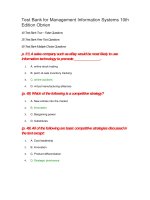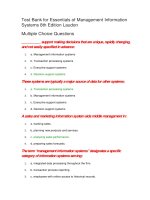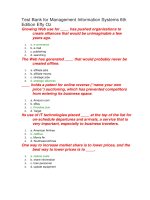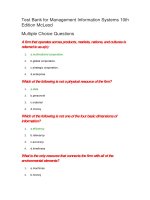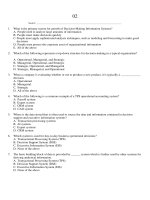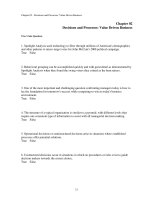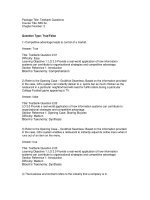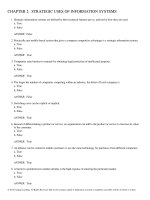Management information systems 3rd edition by rainer prince watson test bank
Bạn đang xem bản rút gọn của tài liệu. Xem và tải ngay bản đầy đủ của tài liệu tại đây (444.32 KB, 34 trang )
Management Information Systems 3rd edition by
Rainer Prince Watson Test Bank
Link full download test bank: />Question Type: True/False
1) Competitive advantage leads to control of a
market. Answer: True
Title: Testbank Question 2.01
Difficulty: Easy
Learning Objective 1: LO 2.0 Provide a real-world application of how information
systems can contribute to organizational strategies and competitive advantage.
Section Reference 1: Introduction
Bloom’s Taxonomy: Comprehension
2) Refer to the Opening Case – GrubHub Seamless: Based on the information provided
in the case, GS’s system can instantly deliver to a sports bar as much chicken as the
restaurant in a particular neighborhood will need for fulfill orders during a particular
College Football game appearing to TV.
Answer: false
Title: Testbank Question 2.02
LO 2.0 Provide a real-world application of how information systems can contribute
to organizational strategies and competitive advantage. Section Reference 1:
Opening Case: Sharing Bicycles
Difficulty: Medium
Bloom’s Taxonomy: Synthesis
3) Refer to the Opening Case – GrubHub Seamless: Based on the information provided
in the case, GS’s system enables a restaurant to instantly adjust its online menu when
it runs out of an item on the menu.
Answer: true
Title: Testbank Question 2.03
Learning Objective 1: LO 2.0 Provide a real-world application of how information
systems can contribute to organizational strategies and competitive advantage.
Section Reference 1: Introduction
Difficulty: Medium
Bloom’s Taxonomy: Synthesis
4) The business environment refers to the industry that a company is in.
Answer: False
Title: Testbank Question 2.04
Learning Objective 1: LO 2.1 Identify effective IT responses to different kinds of business
pressures
Section Reference 1: 2.1 Business Pressures, Organizational Responses, and IT
Support
Difficulty: Easy
Bloom’s Taxonomy: Comprehension
5) A Competitive advantage helps an organization to control a market and to
accrue larger-than-average profits.
Answer: True
Title: Testbank Question 2.05
Learning Objective 1: LO 2.1 Identify effective IT responses to different kinds of business
pressures
Section Reference 1: 2.1 Business Pressures, Organizational Responses, and IT
Support
Difficulty: Easy
Bloom’s Taxonomy: Comprehension
6) Globalization is the integration and interdependence of many facets of life
made possible by rapid advances in information technology.
Answer: True
Title: Testbank Question 2.06
Learning Objective 1: LO 2.1 Identify effective IT responses to different kinds of business
pressures
Section Reference 1: Introduction
Difficulty: Easy
Bloom’s Taxonomy: Comprehension
7) Acquiring competitive advantage is essential for your organization’s survival.
Organizations achieve competitive advantage only through the efforts of their
employees.
Answer: False
Title: Testbank Question 2.07
Learning Objective 1: LO 2.1 Identify effective IT responses to different kinds of business
pressures
Section Reference 1: Introduction
Difficulty: Medium
Bloom’s Taxonomy: Analysis
8) The information technology environment is the combination of social, legal, economic,
physical, and political factors that affect business activities.
Answer: False
Title: Testbank Question 2.08
Learning Objective 1: LO 2.1 Identify effective IT responses to different kinds of business
pressures
Section Reference 1: 2.1 Business Pressures, Organizational Responses, and IT
Support
Difficulty: Easy
Bloom’s Taxonomy: Analysis
9) In general, labor costs are higher in developed countries than in developing countries.
Answer: True
Title: Testbank Question 2.09
Learning Objective 1: LO 2.1 Identify effective IT responses to different kinds of business
pressures
Section Reference 1: 2.1 Business Pressures, Organizational Responses, and IT
Support
Difficulty: Easy
Bloom’s Taxonomy: Application
10) According to Thomas Friedman, there are four eras of
globalization. Answer: True
Title: Testbank Question 2.10
Learning Objective 1: LO 2.1 Identify effective IT responses to different kinds of business
pressures
Section Reference 1: 2.1 Business Pressures, Organizational Responses, and IT
Support
Difficulty: Easy
Bloom’s Taxonomy: Comprehension
11) Developed countries usually provide greater fringe benefits than
developing countries.
Answer: True
Title: Testbank Question 2.11
Learning Objective 1: LO 2.1 Identify effective IT responses to different kinds of business
pressures
Section Reference 1: 2.1 Business Pressures, Organizational Responses, and IT
Support
Difficulty: Easy
Bloom’s Taxonomy: Analysis
12) Information technology is facilitating the entry of a wide variety of employees into
the workforce.
Answer: True
Title: Testbank Question 2.12
Learning Objective 1: LO 2.1 Identify effective IT responses to different kinds of business
pressures
Section Reference 1: 2.1 Business Pressures, Organizational Responses, and IT
Support
Difficulty: Easy
Bloom’s Taxonomy: Application
13) Internet access in the United States is not particularly related to household
income. Answer: False
Title: Testbank Question 2.13
Learning Objective 1: LO 2.1 Identify effective IT responses to different kinds of business
pressures
Section Reference 1: 2.1 Business Pressures, Organizational Responses, and IT
Support
Difficulty: Easy
Bloom’s Taxonomy: Application
14) In general, government deregulation decreases competition.
Answer: False
Title: Testbank Question 2.14
Learning Objective 1: LO 2.1 Identify effective IT responses to different kinds of business
pressures
Section Reference 1: 2.1 Business Pressures, Organizational Responses, and IT
Support
Difficulty: Easy
Bloom’s Taxonomy: Application
15) Ethical issues are important because, if handled poorly, they can damage
an organization’s image.
Answer: True
Title: Testbank Question 2.15
Learning Objective 1: LO 2.1 Identify effective IT responses to different kinds of business
pressures
Section Reference 1: 2.1 Business Pressures, Organizational Responses, and IT
Support
Difficulty: Easy
Bloom’s Taxonomy: Application
16) Build-to-stock is a strategy of producing customized products and services.
Answer: False
Title: Testbank Question 2.16
Learning Objective 1: LO 2.1 Identify effective IT responses to different kinds of business
pressures
Section Reference 1: 2.1 Business Pressures, Organizational Responses, and IT
Support
Difficulty: Easy
Bloom’s Taxonomy: Comprehension
17) In mass production, a company produces a large quantity of identical
items. Answer: True
Title: Testbank Question 2.17
Learning Objective 1: LO 2.1 Identify effective IT responses to different kinds of business
pressures
Section Reference 1: 2.1 Business Pressures, Organizational Responses, and IT
Support
Difficulty: Easy
Bloom’s Taxonomy: Comprehension
18) In mass customization, companies produce items in large quantity, but they tailor
the items to meet the desires and needs of individual customers.
Answer: True
Title: Testbank Question 2.18
Learning Objective 1: LO 2.1 Identify effective IT responses to different kinds of business
pressures
Section Reference 1: 2.1 Business Pressures, Organizational Responses, and IT
Support
Difficulty: Easy
Bloom’s Taxonomy: Comprehension
19) Customer intimacy is the process whereby a business learns as much as
possible about its customers to better anticipate and address their needs.
Answer: True
Title: Testbank Question 2.19
Learning Objective 1: LO 2.1 Identify effective IT responses to different kinds of business
pressures
Section Reference 1: 2.1 Business Pressures, Organizational Responses, and IT
Support
Difficulty: Easy
Bloom’s Taxonomy: Knowledge
20) A growing IT initiative called green IT is enabling organizations to reduce their
carbon footprint.
Answer: True
Title: Testbank Question 2.20
Learning Objective 1: LO 2.1 Identify effective IT responses to different kinds of business
pressures
Section Reference 1: 2.1 Business Pressures, Organizational Responses, and IT
Support
Difficulty: Easy
Bloom’s Taxonomy: Knowledge
21) The digital divide is the gap between data and knowledge.
Answer: False
Title: Testbank Question 2.21
Learning Objective 1: LO 2.1 Identify effective IT responses to different kinds of business
pressures
Section Reference 1: 2.1 Business Pressures, Organizational Responses, and IT
Support
Difficulty: Easy
Bloom’s Taxonomy: Knowledge
22) The One Laptop per Child project aims to use technology to revolutionize how the
world can educate its children.
Answer: True
Title: Testbank Question 2.22
Learning Objective 1: LO 2.1 Identify effective IT responses to different kinds of business
pressures
Section Reference 1: 2.1 Business Pressures, Organizational Responses, and IT
Support
Difficulty: Easy
Bloom’s Taxonomy: Application
23) Competitive advantage helps a company function effectively within a market and
generate larger-than-average profits.
Answer: True
Title: Testbank Question 2.23
Learning Objective 1: LO 2.2 Describe the strategies that organizations typically adopt
to counter Porter’s five competitive forces.
Section Reference 1: 2.2 Competitive Advantage and Strategic Information Systems
Difficulty: Easy
Bloom’s Taxonomy: Application
24) An information system that helps an organization gain a competitive advantage
is called a competitive information system.
Answer: False
Title: Testbank Question 2.24
Learning Objective 1: LO 2.2 Describe the strategies that organizations typically adopt to
counter Porter’s five competitive forces.
Section Reference 1: 2.2 Competitive Advantage and Strategic Information Systems
Difficulty: Easy
Bloom’s Taxonomy: Application
25) Every competitive organization is driven by the competitive forces identified
by Michael Porter.
Answer: True
Title: Testbank Question 2.25
Learning Objective 1: LO 2.2 Describe the strategies that organizations typically adopt
to counter Porter’s five competitive forces.
Section Reference 1: 2.2 Competitive Advantage and Strategic Information Systems
Difficulty: Easy
Bloom’s Taxonomy: Comprehension
26) Michael Porter concludes that the overall impact of the Internet is to
increase competition, which generally diminishes a firm’s profitability.
Answer: True
Title: Testbank Question 2.26
Learning Objective 1: LO 2.2 Describe the strategies that organizations typically adopt
to counter Porter’s five competitive forces.
Section Reference 1: 2.2 Competitive Advantage and Strategic Information Systems
Difficulty: Easy
Bloom’s Taxonomy: Comprehension
27) The Internet increases traditional barriers to entry into a market.
Answer: False
Title: Testbank Question 2.27
Learning Objective 1: LO 2.2 Describe the strategies that organizations typically adopt to
counter Porter’s five competitive forces.
Section Reference 1: 2.2 Competitive Advantage and Strategic Information Systems
Difficulty: Easy
Bloom’s Taxonomy: Comprehension
28) The Internet decreases customers’ bargaining power.
Answer: False
Title: Testbank Question 2.28
Learning Objective 1: LO 2.2 Describe the strategies that organizations typically adopt
to counter Porter’s five competitive forces.
Section Reference 1: 2.2 Competitive Advantage and Strategic Information Systems
Difficulty: Easy
Bloom’s Taxonomy: Comprehension
29) Information-based industries face the greatest threat from substitutes.
Answer: True
Title: Testbank Question 2.29
Learning Objective 1: LO 2.2 Describe the strategies that organizations typically adopt
to counter Porter’s five competitive forces.
Section Reference 1: 2.2 Competitive Advantage and Strategic Information Systems
Difficulty: Easy
Bloom’s Taxonomy: Comprehension
30) The music industry is a good example of the extremely low variable costs of digital
products.
Answer: True
Title: Testbank Question 2.30
Learning Objective 1: LO 2.2 Describe the strategies that organizations typically adopt
to counter Porter’s five competitive forces.
Section Reference 1: 2.2 Competitive Advantage and Strategic Information Systems
Difficulty: Easy
Bloom’s Taxonomy: Application
31) The introduction of the ATM in the banking industry is an example of the
innovation strategy.
Answer: True
Title: Testbank Question 2.31
Learning Objective 1: LO 2.2 Describe the strategies that organizations typically adopt to
counter Porter’s five competitive forces.
Section Reference 1: 2.2 Competitive Advantage and Strategic Information Systems
Difficulty: Easy
Bloom’s Taxonomy: Application
32) An entry barrier is a long-term competitive advantage.
Answer: False
Title: Testbank Question 2.32
Learning Objective 1: LO 2.2 Describe the strategies that organizations typically adopt
to counter Porter’s five competitive forces.
Section Reference 1: 2.2 Competitive Advantage and Strategic Information Systems
Difficulty: Easy
Bloom’s Taxonomy: Comprehension
33) The bargaining power of suppliers is low when their buyers have many
choices. Answer: True
Title: Testbank Question 2.33
Learning Objective 1: LO 2.2 Describe the strategies that organizations typically adopt to
counter Porter’s five competitive forces.
Section Reference 1: 2.2 Competitive Advantage and Strategic Information Systems
Difficulty: Easy
Bloom’s Taxonomy: Comprehension
34) When there are many substitute products, a company can create a
competitive advantage by increasing fees.
Answer: False
Title: Testbank Question 2.34
Learning Objective 1: LO 2.2 Describe the strategies that organizations typically adopt
to counter Porter’s five competitive forces.
Section Reference 1: 2.2 Competitive Advantage and Strategic Information Systems
Difficulty: Easy
Bloom’s Taxonomy: Comprehension
35) Porter’s value chain model is a variation of his competitive advantage framework.
Answer: False
Title: Testbank Question 2.35
Learning Objective 1: LO 2.2 Describe the strategies that organizations typically adopt
to counter Porter’s five competitive forces.
Section Reference 1: 2.2 Competitive Advantage and Strategic Information Systems
Difficulty: Easy
Bloom’s Taxonomy: Comprehension
36) The primary activities in the value chain create the value for which customers are
willing to pay.
Answer: True
Title: Testbank Question 2.36
Learning Objective 1: LO 2.2 Describe the strategies that organizations typically adopt
to counter Porter’s five competitive forces.
Section Reference 1: 2.2 Competitive Advantage and Strategic Information Systems
Difficulty: Easy
Bloom’s Taxonomy: Comprehension
37) It’s a good idea for a company to select two competitive advantage strategies.
Answer: False
Title: Testbank Question 2.37
Learning Objective 1: LO 2.2 Describe the strategies that organizations typically adopt
to counter Porter’s five competitive forces.
Section Reference 1: 2.2 Competitive Advantage and Strategic Information Systems
Difficulty: Easy
Bloom’s Taxonomy: Comprehension
38) The strategic impact of Information systems impacts small or medium-sized
companies differently than it impacts a large firm.
Answer: False
Title: Testbank Question 2.38
Learning Objective 1: LO 2.2 Describe the strategies that organizations typically adopt to
counter Porter’s five competitive forces.
Section Reference 1: 2.2 Competitive Advantage and Strategic Information Systems
Difficulty: Medium
Bloom’s Taxonomy: Application
Question Type: Multiple Choice
39) Which of the following statements is false?
a) Competitive advantage is based on some measurement such as cost, quality,
or speed.
b) Competitive advantage enables a company to function effectively within a market.
c) Competitive advantage leads to higher-than-average profits.
d) Competitive advantage requires the use of technology.
e) Competitive advantage applies to companies of all sizes.
Answer: d
Title: Testbank Question 2.39
Learning Objective 1: LO 2.0 Provide a real-world application of how information
systems can contribute to organizational strategies and competitive advantage.
Section Reference 1: Introduction
Difficulty: Easy
Bloom’s Taxonomy: Comprehension
40) Business pressures on organizations are created when there are changes in
___________.
a) Social factors
b) Economic factors
c) Legal factors
d) Political factors
e) Changes in all of the above will create business pressures.
Answer: e
Title: Testbank Question 2.40
Learning Objective 1: LO 2.1 Identify effective IT responses to different kinds of business
pressures
Section Reference 1: 2.1 Business Pressures, Organizational Responses, and IT
Support
Difficulty: Easy
Bloom’s Taxonomy: Comprehension
41) Market pressures include which of the following?
a) The global economy
b) Weak competition
c) A homogeneous workforce
d) Weak customers
e) High-cost offshore labor
Answer: a
Title: Testbank Question 2.41
Learning Objective 1: LO 2.1 Identify effective IT responses to different kinds of business
pressures
Section Reference 1: 2.1 Business Pressures, Organizational Responses, and IT
Support
Difficulty: Easy
Bloom’s Taxonomy: Comprehension
42) The workforce in developed countries is exhibiting all of the following trends except
_____________.
a) It is becoming more diversified.
b) It includes more women.
c) It includes more single parents.
d) It includes fewer persons with disabilities.
e) It includes more minority-group members.
Answer: d
Title: Testbank Question 2.42
Learning Objective 1: LO 2.1 Identify effective IT responses to different kinds of business
pressures
Section Reference 1: 2.1 Business Pressures, Organizational Responses, and IT
Support
Difficulty: Medium
Bloom’s Taxonomy: Application
43) Ted works in his family’s bakery business. They supply bread and rolls to neighboring
restaurants, and they have their own store front where they sell breads, rolls, pastries,
cookies and cupcakes. Ted wants to start being able to ship an order that comes in from
their Web site. This idea reflects:
a) An organizational response to business pressures.
b) A technology response to business pressures.
c) A response to powerful customers
d) A response to globalization.
e) An effort to “go green.”
Answer: d
Title: Testbank Question 2.43
Learning Objective 1: LO 2.1 Identify effective IT responses to different kinds of business
pressures
Section Reference 1: 2.1 Business Pressures, Organizational Responses, and IT
Support
Difficulty: Medium
Bloom’s Taxonomy: Evaluation
44) Today’s customers have ________.
a) less knowledge about products
b) less sophistication
c) difficulty in finding information about products
d) higher expectations
e) difficulty in comparing prices
Answer: d
Title: Testbank Question 2.44
Learning Objective 1: LO 2.1 Identify effective IT responses to different kinds of business
pressures
Section Reference 1: 2.1 Business Pressures, Organizational Responses, and IT
Support
Difficulty: Easy
Bloom’s Taxonomy: Analysis
45) Ted works in his family’s bakery business. They supply bread and rolls to
neighboring restaurants, and they have their own storefront where they sell breads, rolls,
pastries, cookies, and cupcakes. Ted knows he needs to understand more about his
customers to anticipate their needs. This is called __________.
a) Customer data
b) Customer knowledge
c) Customer intimacy
d) Customer information
e) Customer processing
Answer: c
Title: Testbank Question 2.45
Learning Objective 1: LO 2.1 Identify effective IT responses to different kinds of business
pressures
Section Reference 1: 2.1 Business Pressures, Organizational Responses, and IT
Support
Difficulty: Easy
Bloom’s Taxonomy: Analysis
46) Which of the following statements concerning technology pressures on modern
businesses is true?
a) Technology changes so rapidly that organizations should wait before they release
new technology-based products.
b) New technologies offer alternative service options.
c) New technologies will never replace existing technologies.
d) The amount of information on the Internet remains stable from year to year.
e) The important information on the Internet is fee-based.
Answer: b
Title: Testbank Question 2.46
Learning Objective 1: LO 2.1 Identify effective IT responses to different kinds of business
pressures
Section Reference 1: 2.1 Business Pressures, Organizational Responses, and IT
Support
Difficulty: Medium
Bloom’s Taxonomy: Analysis
47) The acronym BOYD stands for what?
a) Backup Your Own Data
b) Buy Your own Device
c) Bring Your Own Data
d) Bring Your Own Device
Answer: d
Title: Testbank Question 2.47
Learning Objective 1: LO 2.1 Identify effective IT responses to different kinds of business
pressures
Section Reference 1: 2.1 Business Pressures, Organizational Responses, and IT
Support
Difficulty: Medium
Bloom’s Taxonomy: Application
48) Refer to IT’s About Business 2.1 – “Bring Your Own Device” Can Cause Problems:
Hamilton Fraser uses Mobiletron to provide device management and security to manage
devices employees want to connect to the corporate network. Which of the following is
not a correct statement? HP uses Mobiletron to __________.
a) erase corporate data from personal devices if lost or stolen.
b) track how many employees were access corporate network.
c) track if employee is using network for shopping or playing games.
d) determine if the device being used is approved.
e) All of the choices are correct.
Answer: e
Title: Testbank Question 2.48
Learning Objective 1: LO 2.1: Identify effective IT responses to different kinds of
business pressures
Section Reference 1: IT’s About Business2.1 - “Bring Your Own Device” Can Cause
Problems
Difficulty: Medium
Bloom’s Taxonomy: Application
49) Which of the following is not an example of the growing initiative called green IT?
a) Designing an IT infrastructure to support sustainability.
b) Building systems that monitor carbon throughout the organization.
c) Asking vendors about compliance on environmental standards.
d) Building computer applications that use less energy
e) Designing energy-efficient data centers.
Answer: d
Title: Testbank Question 2.49
Learning Objective 1: LO 2.1 Identify effective IT responses to different kinds of business
pressures
Section Reference 1: 2.1 Business Pressures, Organizational Responses, and IT
Support
Difficulty: Easy
Bloom’s Taxonomy: Analysis
50) The digital divide is an example of which type of societal pressure?
a) social responsibility
b) government regulations
c) protection against terrorism
d) ethics
e) information overload
Answer: a
Title: Testbank Question 2.50
Learning Objective 1: LO 2.1 Identify effective IT responses to different kinds of business
pressures
Section Reference 1: 2.1 Business Pressures, Organizational Responses, and IT
Support
Difficulty: Easy
Bloom’s Taxonomy: Analysis
51) Ted works in his family’s bakery business. They supply bread and rolls to
neighboring restaurants, and they have their own storefront where they sell breads, rolls,
pastries, cookies and cupcakes. At the end of each day, Ted drives the day old products
to the local homeless shelter and donates them. This idea reflects __________.
a) An organizational response to business pressures.
b) A technology response to business pressures.
c) A response to powerful customers
d) A response to globalization.
e) Social responsibility.
Answer: e
Title: Testbank Question 2.51
Learning Objective 1: LO 2.1 Identify effective IT responses to different kinds of business
pressures
Section Reference 1: 2.1 Business Pressures, Organizational Responses, and IT
Support
Difficulty: Easy
Bloom’s Taxonomy: Evaluation
52) Refer to IT’s About Business 2.2 - Solar-Powered Tablets in Ethiopia: Based on the
information provided, which of the following did the children receiving the SolarPowered Tablets in Ethiopia not do?
a) Access the operating system.
b) Learn to use the tablet’s camera.
c) Learn to send messages to one another.
d) Learn to customize their desktops.
e) Learn to sing in English.
Answer: c
Title: Testbank Question 2.52
Learning Objective 1: LO 2.1 Identify effective IT responses to different kinds of
business pressures
Section Reference 1: IT’s About Business 2.2 - Solar-Powered Tablets in Ethiopia
Difficulty: Medium
Bloom’s Taxonomy: Comprehension
53) Which one of the following statements is false?
a) Businesses tend to view government regulations as expensive constraints on
their activities.
b) Government deregulation reduces competition.
c) IT support is essential for compliance with many new regulations.
d) IT has been used to identify patterns of behavior associated with terrorist activities.
e) Information ethics can destroy the morale of a company’s employees.
Answer: b
Title: Testbank Question 2.53
Learning Objective 1: LO 2.1 Identify effective IT responses to different kinds of business
pressures
Section Reference 1: 2.1 Business Pressures, Organizational Responses, and IT
Support
Difficulty: Easy
Bloom’s Taxonomy: Comprehension
54) Refer to IT’s About Business 2.3 – The Weather Channel: Which of the following is
not a listed reason for the drop in viewership of TWC?
a) Other startup services providing online weather information
b) Lack of catastrophic weather
c) Changing viewer expectations of what a weathercast should be
d) Viewers increase use of mobile devices
e) Cable services providing weathercasts from other services
Answer: e
Title: Testbank Question 2.54
Learning Objective 1: LO 2.1 Identify effective IT responses to different kinds of
business pressures
Section Reference 1: IT’s About Business 2.3 – The Weather Channel:
Difficulty: Medium
Bloom’s Taxonomy: Comprehension
55) Which of the following is not a response by organizations to business pressures?
a) Delay releases of innovated products.
b) Build strategic systems that enable an organization to increase market share or profits.
c) Provide tools that satisfy customers so they don’t go to a competitor.
d) Manufacture customized goods at a lower cost.
e) Conduct business electronically with customers and business partners.
Answer: a
Title: Testbank Question 2.55
Learning Objective 1: LO 2.1 Identify effective IT responses to different kinds of business
pressures
Section Reference 1: 2.1 Business Pressures, Organizational Responses, and IT
Support
Difficulty: Medium
Bloom’s Taxonomy: Comprehension
56) Producing identical items in large quantities is called ____________.
a) strategic systems.
b) customer focus.
c) continuous improvement.
d) mass production.
e) mass customization.
Answer: d
Title: Testbank Question 2.56
Learning Objective 1: LO 2.1 Identify effective IT responses to different kinds of business
pressures
Section Reference 1: 2.1 Business Pressures, Organizational Responses, and IT
Support
Difficulty: Easy
Bloom’s Taxonomy: Knowledge
57) Producing customized items in large quantities is called __________.
a) strategic systems.
b) customer focus.
c) continuous improvement.
d) mass production.
e) mass customization.
Answer: e
Title: Testbank Question 2.57
Learning Objective 1: LO 2.1 Identify effective IT responses to different kinds of business
pressures
Section Reference 1: 2.1 Business Pressures, Organizational Responses, and IT
Support
Difficulty: Easy
Bloom’s Taxonomy: Knowledge
58) The Bodymetrics body scanner is best characterized as an example of _________.
a) mass production.
b) customer focus.
c) real-time customer input.
d) mass customization.
e) continuous improvement.
Answer: d
Title: Testbank Question 2.58
Learning Objective 1: LO 2.1 List and provide examples of the three types of business
pressures, and describe one IT response to each.
Section Reference 1: 2.1 Business Pressures, Organizational Responses, and
Information Technology Support
Difficulty: Medium
Bloom’s Taxonomy: Application
59) Ted works in his family’s bakery business. They supply bread and rolls to
neighboring restaurants, and they have their own storefront where they sell breads, rolls,
pastries, cookies, and cupcakes. Ted wants to build a Web site for the business that will
allow customers to order cookies and cupcakes for later pickup. This idea represents
______________.
a) An organizational response to business pressures.
b) A technology response to business pressures.
c) A response to powerful customers
d) A response to globalization.
e) An effort to “go green.”
Answer: a
Title: Testbank Question 2.59
Learning Objective 1: LO 2.1 Identify effective IT responses to different kinds of business
pressures
Section Reference 1: 2.1 Business Pressures, Organizational Responses, and IT
Support
Difficulty: Medium
Bloom’s Taxonomy: Evaluation
60) Ted works in his family’s bakery business. They supply bread and rolls to
neighboring restaurants, and they have their own storefront where they sell breads, rolls,
pastries, cookies, and cupcakes. They’ve started making cupcakes but not frosting them.
When a customer buys a cupcake, he/she specifies the flavor of frosting. This idea
represents ___________.
a) Customer service
b) Mass-production
c) Made-to-order
d) Customization
e) Mass-customization.
Answer: e
Title: Testbank Question 2.60
Learning Objective 1: LO 2.1 Identify effective IT responses to different kinds of business
pressures
Section Reference 1: 2.1 Business Pressures, Organizational Responses, and IT
Support
Difficulty: Easy
Bloom’s Taxonomy: Evaluation
61) Information-based industries are most susceptible to which one of Porter’s five
forces?
a) threat of entry of new competitors
b) bargaining power of suppliers
c) bargaining power of customers
d) threat of substitute products
e) rivalry among existing firms in an industry
Answer: d
Title: Testbank Question 2.61
Learning Objective 1: LO 2.2 Describe the strategies that organizations typically adopt to
counter Porter’s five competitive forces.
Section Reference 1: 2.2 Competitive Advantage and Strategic Information Systems
Difficulty: Medium
Bloom’s Taxonomy: Analysis
62) Ted works in his family’s bakery business. They supply bread and rolls to neighboring
restaurants, and they have their own store front where they sell breads, rolls, pastries,
cookies and cupcakes. Ted wants to start offering gluten free products. Customers have
been asking for them and leaving when he tells them he doesn’t have any. This idea
reflects which one of Porter’s five competitive forces?
a) threat of entry of new competitors
b) bargaining power of suppliers
c) bargaining power of customers
d) threat of substitute products
e) rivalry among existing firms in an industry
Answer: d
Title: Testbank Question 2.62
Learning Objective 1: LO 2.2 Describe the strategies that organizations typically adopt
to counter Porter’s five competitive forces.
Section Reference 1: 2.2 Competitive Advantage and Strategic Information Systems
Difficulty: Medium
Bloom’s Taxonomy: Analysis
63) Competitive advantage for an organization manifests itself as all of the
following except __________.
a) Lower costs
b) Higher quality
c) Increased time to market
d) Increased profits
e) Increased speed
Answer: c
Title: Testbank Question 2.63
Learning Objective 1: LO 2.2 Describe the strategies that organizations typically adopt
to counter Porter’s five competitive forces.
Section Reference 1: 2.2 Competitive Advantage and Strategic Information Systems
Difficulty: Medium
Bloom’s Taxonomy: Analysis
64) For most companies, the Web _____ the threat that new competitors will enter
the market by _____ traditional barriers to entry.
a) decreases, increasing
b) increases, decreasing
c) increases, increasing
d) decreases, decreasing
Answer: b
Title: Testbank Question 2.64
Learning Objective 1: LO 2.2 Describe the strategies that organizations typically adopt
to counter Porter’s five competitive forces.
Section Reference 1: 2.2 Competitive Advantage and Strategic Information Systems
Difficulty: Medium
Bloom’s Taxonomy: Analysis
65) Which of the following statements is False concerning Strategic Information
Systems?
a) Strategic Information Systems provide a competitive advantage.
b) Strategic Information Systems help an organization implement its strategic goals.
c) Strategic Information Systems are only an information system that reduces a
competitive disadvantage.
d) Strategic Information Systems improve an organization’s performance and
productivity
Answer: c
Title: Testbank Question 2.65
Learning Objective 1: LO 2.2 Describe the strategies that organizations typically adopt
to counter Porter’s five competitive forces.
Section Reference 1: 2.2 Competitive Advantage and Strategic Information Systems
Difficulty: Medium
Bloom’s Taxonomy: Synthesis
66) _____ is a feature that must be offered by a competing organization in order
to survive in the marketplace.
a) Competitive advantage
b) An entry barrier
c) Strategic advantage
d) Rapid time-to-market
e) One-to-one marketing
Answer: b
Title: Testbank Question 2.66
Learning Objective 1: LO 2.2 Describe the strategies that organizations typically adopt
to counter Porter’s five competitive forces.
Section Reference 1: 2.2 Competitive Advantage and Strategic Information Systems
Difficulty: Medium
Bloom’s Taxonomy: Comprehension
67) The threat of competitors’ entering the automobile manufacturing industry is _____
because barriers to entry are so _____.
a) low, low
b) high, high
c) high, low
d) low, high
Answer: d
Title: Testbank Question 2.67
Learning Objective 1: LO 2.2 Describe the strategies that organizations typically adopt
to counter Porter’s five competitive forces.
Section Reference 1: 2.2 Competitive Advantage and Strategic Information Systems
Difficulty: Medium
Bloom’s Taxonomy: Analysis
68) The threat of competitors’ entering a market is very high in industries that perform
a(n) _____ role and in industries where the primary product or service is _____.
a) intermediation, physical
b) broker, physical
c) sales, financial
d) financial, digital
e) intermediation, digital
Answer: e
Title: Testbank Question 2.68
Learning Objective 1: LO 2.2 Describe the strategies that organizations typically adopt to
counter Porter’s five competitive forces.
Section Reference 1: 2.2 Competitive Advantage and Strategic Information Systems
Difficulty: Hard
Bloom’s Taxonomy: Synthesis
69) How does the Internet affect the way you purchase your textbooks?
a) The Internet gives you fewer choices.
b) The Internet increases your bargaining power.
c) The Internet provides you with less information.
d) The Internet decreases your bargaining power.
e) The Internet increases your switching costs.
Answer: b
Title: Testbank Question 2.69
Learning Objective 1: LO 2.2 Describe the strategies that organizations typically adopt
to counter Porter’s five competitive forces.
Section Reference 1: 2.2 Competitive Advantage and Strategic Information Systems
Difficulty: Medium
Bloom’s Taxonomy: Synthesis
70) Buyer power is _____ when buyers have many choices from whom to buy and
_____ when buyers have few choices.
a) high, the same
b) high, low
c) low, low
d) low, high
e) low, the same
Answer: b
Title: Testbank Question 2.70
Learning Objective 1: LO 2.2 Describe the strategies that organizations typically adopt
to counter Porter’s five competitive forces.
Section Reference 1: 2.2 Competitive Advantage and Strategic Information Systems
Difficulty: Medium
Bloom’s Taxonomy: Synthesis
71) The costs of delivering products in the _____ channel are much higher
than delivering products in the _____ channel.
a) e-commerce, digital
b) digital, e-commerce
c) digital, physical
d) physical, financial
e) physical, digital
Answer: e
Title: Testbank Question 2.71
Learning Objective 1: LO 2.2 Describe the strategies that organizations typically adopt
to counter Porter’s five competitive forces.
Section Reference 1: 2.2 Competitive Advantage and Strategic Information Systems
Difficulty: Medium
Bloom’s Taxonomy: Synthesis
72) Porter’s competitive forces model helps organizations identify _____, whereas his
value chain model helps organizations identify specific _____.
a) competitive opportunities, activities
b) general strategies, activities
c) activities, competitive opportunities
d) activities, general strategies
e) primary activities, support activities
Answer: b
Title: Testbank Question 2.72
Learning Objective 1: LO 2.2 Describe the strategies that organizations typically adopt to
counter Porter’s five competitive forces.
Section Reference 1: 2.2 Competitive Advantage and Strategic Information Systems
Difficulty: Hard
Bloom’s Taxonomy: Evaluation
73) _____ activities create value for which customers are willing to pay, whereas _____
activities do not add value directly to the firm’s products or services.
a) Support, primary
b) Human resource management, inbound logistics
c) Procurement, operations
d) Primary, support
e) Accounting, outbound logistics
Answer: d
Title: Testbank Question 2.73
Learning Objective 1: LO 2.2 Describe the strategies that organizations typically adopt
to counter Porter’s five competitive forces.
Section Reference 1: 2.2 Competitive Advantage and Strategic Information Systems
Difficulty: Medium
Bloom’s Taxonomy: Evaluation
74) If there are _____ substitutes for an organization’s products or services, then the
threat of substitutes is _____.
a) many, high
b) few, low
c) few, high
d) many, low
e) few, negligible
Answer: a
Title: Testbank Question 2.74
Learning Objective 1: LO 2.2 Describe the strategies that organizations typically adopt
to counter Porter’s five competitive forces.
Section Reference 1: 2.2 Competitive Advantage and Strategic Information Systems
Difficulty: Medium
Bloom’s Taxonomy: Synthesis
75) New technologies can produce new products very _____, which _____ the threat
from substitute products.
a) slowly, decreases
b) slowly, increases
c) slowly, does not affect
d) quickly, increases
e) quickly, does not affect
Answer: d
Title: Testbank Question 2.75
Learning Objective 1: LO 2.2 Describe the strategies that organizations typically adopt
to counter Porter’s five competitive forces.
Section Reference 1: 2.2 Competitive Advantage and Strategic Information Systems
Difficulty: Medium
Bloom’s Taxonomy: Synthesis
76) The visibility of Internet applications on the Web makes proprietary systems
more difficult to keep secret. This is an example of which of Porter’s five forces?
a) threat of entry of new competitors
b) bargaining power of suppliers
c) bargaining power of customers
d) threat of substitute products
e) rivalry among existing firms in an industry
Answer: e
Title: Testbank Question 2.76
Learning Objective 1: LO 2.2 Describe the strategies that organizations typically adopt to
counter Porter’s five competitive forces.
Section Reference 1: 2.2 Competitive Advantage and Strategic Information Systems
Difficulty: Medium
